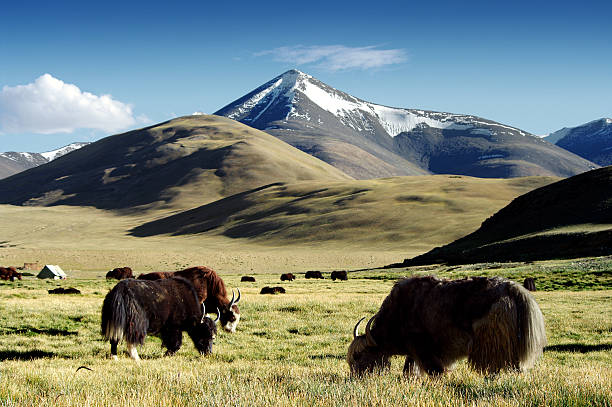
As the sun sets over Ladakh’s barren Himalayan expanse, 32-year-old Tsering Dolma guides a small herd of yaks into a stone corral, her infant son strapped to her back. On these wind-blown high-altitude plains, where sparse grass merges into gravel and jagged mountains, herders like Dolma are becoming a rare sight.
For generations, Ladakh’s yak herders have relied on seasonal snowmelt to nourish the alpine meadows where their livestock graze. But changing weather patterns have disrupted this delicate ecosystem. “We used to get regular snow and rain,” Dolma says. “Now it’s far less, and winters are warmer.”
In nearby Maan village, the traditional rhythms of life continue—at least for now. At dawn, Tanzin Dolma milks a yak while her husband gathers dung, essential for fuel in this treeless region. Much of the herding and wool processing is still done manually, with women bearing much of the daily labor.
Further down the valley, 73-year-old Kunzias Dolma brews yak milk tea and churns butter while spinning a Buddhist prayer wheel. She has spent her life working with yaks, turning their milk into dairy products and their wool into clothing. “We start before sunrise and don’t stop until after sunset,” she says.
Yet this ancient lifestyle is fading. With rising temperatures and erratic precipitation, yaks—adapted to cold and dependent on lush pastures—are struggling to survive. Scientific data shows Ladakh has warmed by 3°C over the past 40 years, intensifying heatwaves and disrupting rainfall.
The consequences are stark. Government data reveals a sharp drop in Ladakh’s yak population—from nearly 34,000 in 2012 to under 20,000 by 2019. Though yaks remain plentiful in other regions, Ladakh’s fragile alpine environment is especially vulnerable to climate impacts.
“There used to be so many yaks,” says herder Kunzang Angmo. “But now the snowfall and grass have both decreased.”
Her husband, Tsering Angchok, whose family has reared yaks for generations, reflects on the animal’s central role. “Yaks give us everything—milk, meat, butter, wool, dung. Nothing is wasted. Our forefathers survived because of them.”
But Ladakh’s once-lush meadows are now giving way to invasive plant species, and fertile grazing lands are shrinking. “When I was younger, there was more grass, more water, and more wildlife,” says 70-year-old Thering Norphel. “Now the mountains are just bare rock. No snow, no ice, and barely any grass.”
With fewer resources and harsher conditions, younger generations are leaving the region in search of better opportunities, accelerating the decline of this centuries-old pastoral tradition. As climate change reshapes Ladakh, its iconic yaks—and the people who depend on them—are caught in a battle for survival.
